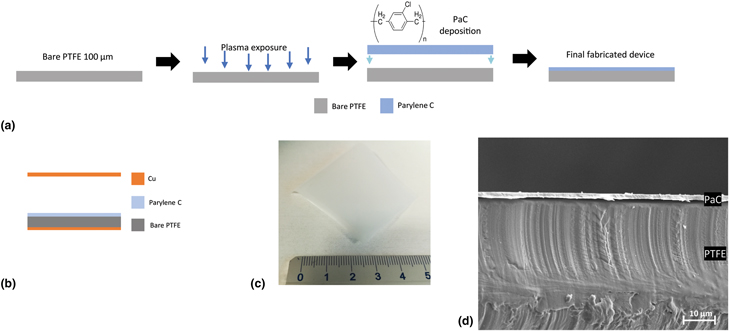Crossref Citations
This article has been cited by the following publications. This list is generated based on data provided by
Crossref.
Mariello, M.
Scarpa, E.
Algieri, L.
Guido, F.
Mastronardi, V. M.
Qualtieri, A.
and
Vittorio, M. De
2019.
Mechanical energy harvesting through a novel flexible contact-separation mode triboelectric nanogenerator based on metallized porous PDMS and Parylene-C.
p.
1.
Mariello, Massimo
Scarpa, Elisa
Algieri, Luciana
Guido, Francesco
Mastronardi, Vincenzo Mariano
Qualtieri, Antonio
and
De Vittorio, Massimo
2020.
Novel Flexible Triboelectric Nanogenerator based on Metallized Porous PDMS and Parylene C.
Energies,
Vol. 13,
Issue. 7,
p.
1625.
Nurmakanov, Yerzhan
Kalimuldina, Gulnur
Nauryzbayev, Galymzhan
Adair, Desmond
and
Bakenov, Zhumabay
2021.
Structural and Chemical Modifications Towards High-Performance of Triboelectric Nanogenerators.
Nanoscale Research Letters,
Vol. 16,
Issue. 1,
Ravichandran, Aravind Narain
Depoutot, Frederic
Kharbouche, Elias
Hamand, Marc
Ramuz, Marc
and
Blayac, Sylvain
2021.
Demonstration of friction-based triboelectric nanogenerator and integration in a power-balanced fully autonomous system.
Nano Energy,
Vol. 83,
Issue. ,
p.
105796.
Liu, Wenlin
Wang, Zhao
and
Hu, Chenguo
2021.
Advanced designs for output improvement of triboelectric nanogenerator system.
Materials Today,
Vol. 45,
Issue. ,
p.
93.
Mariello, Massimo
Fachechi, Luca
Guido, Francesco
and
De Vittorio, Massimo
2021.
Multifunctional sub-100 µm thickness flexible piezo/triboelectric hybrid water energy harvester based on biocompatible AlN and soft parylene C-PDMS-Ecoflex™.
Nano Energy,
Vol. 83,
Issue. ,
p.
105811.
Mariello, Massimo
Fachechi, Luca
Guido, Francesco
and
De Vittorio, Massimo
2021.
Conformal, Ultra‐thin Skin‐Contact‐Actuated Hybrid Piezo/Triboelectric Wearable Sensor Based on AlN and Parylene‐Encapsulated Elastomeric Blend.
Advanced Functional Materials,
Vol. 31,
Issue. 27,
Ali, Fahad
Hussain, Zaryab
Numan, Muhammad
Fatima, Batool
Haq, Muhammad Najam ul
Majeed, Saadat
and
Ahmad, ouseef
2022.
Triboelectric Nanogenerator Based on PTFE Plastic Waste Bottle and Aluminum Foil.
Materials Innovations,
Vol. 2,
Issue. 8,
p.
203.
Quevy, Quentin
Enriquez, Esther
Cornetta, Gianluca
and
Touhafi, Abdellah
2022.
Positive Triboelectric-Affinity Dielectric Production and Analysis. Towards a Self-Powered Acoustic Sensor.
p.
1.
Potu, Supraja
M, Navaneeth
Rajaboina, Rakesh Kumar
Gollapelli, Buchaiah
Vallamkondu, Jayalakshmi
Mishra, Siju
Divi, Haranath
Babu, Anjaly
K, Uday Kumar
and
Kodali, Prakash
2022.
High-Performance and Low-Cost Overhead Projector Sheet-Based Triboelectric Nanogenerator for Self-Powered Cholesteric Liquid Crystal, Electroluminescence, and Portable Electronic Devices.
ACS Applied Energy Materials,
Vol. 5,
Issue. 11,
p.
13702.
Mariello, Massimo
2022.
Recent Advances on Hybrid Piezo-Triboelectric Bio-Nanogenerators: Materials, Architectures and Circuitry.
Nanoenergy Advances,
Vol. 2,
Issue. 1,
p.
64.
Mariello, Massimo
2022.
Heart Energy Harvesting and Cardiac Bioelectronics: Technologies and Perspectives.
Nanoenergy Advances,
Vol. 2,
Issue. 4,
p.
344.
Xin, Chuanfu
Li, Zhongjie
Zhang, Qin
Peng, Yan
Guo, Hengyu
and
Xie, Shaorong
2022.
Investigating the output performance of triboelectric nanogenerators with single/double-sided interlayer.
Nano Energy,
Vol. 100,
Issue. ,
p.
107448.
Sun, Jingzhe
Ren, Bingqi
Han, Seunghye
Shin, Hyungsub
Cha, Seokjun
Lee, Jiwoo
Bae, Jihyun
and
Park, Jong‐Jin
2023.
Amplified Performance of Charge Accumulation and Trapping Induced by Enhancing the Dielectric Constant via the Cyano Group of 3D‐Structured Textile for a Triboelectric Multi‐Modal Sensor.
Small Methods,
Vol. 7,
Issue. 10,
Kassem, Omar
Barnier, Vincent
Nasreldin, Mohamed
Reslan, Jawad
Aoufi, Asdin
Ravichandran, Aravindnarain
Sao-joao, Sergio
Hoummada, Khalid
Charai, Ahmed
Rieu, Mathilde
Viricelle, Jean-Paul
Djenizian, Thierry
and
Mohamed, Saadaoui
2023.
Selective Growth of Graphene-Confined Inkjet-Printed Sn Nanoparticles on Plastic Using Intense Pulsed Light Annealing.
ACS Applied Materials & Interfaces,
Vol. 15,
Issue. 25,
p.
30663.
Kim, Minsoo P.
Lee, Gunoh
Noh, Byeongil
Kim, Jaehyun
Kwak, Min Sub
Lee, Kyung Jin
and
Ko, Hyunhyub
2024.
Enhancing energy harvesting performance of bilayered parylene triboelectric nanogenerators through interfacial polarization.
Nano Energy,
Vol. 119,
Issue. ,
p.
109087.
Sun, Jianfeng
Zhang, Lingjun
Gong, Siqi
Chen, Jie
and
Guo, Hengyu
2024.
Device physics and application prospect of the emerging high-voltage supply technology arising from triboelectric nanogenerator.
Nano Energy,
Vol. 119,
Issue. ,
p.
109010.
Mariello, Massimo
2025.
Advances and Perspectives on Bioelectronic and Atomic Nanogenerators for Anticancer Therapy.
Nanoenergy Advances,
Vol. 5,
Issue. 2,
p.
4.
